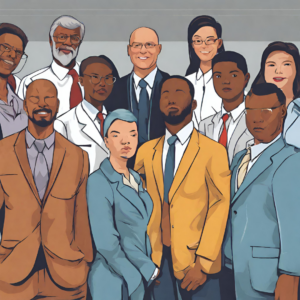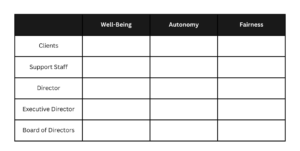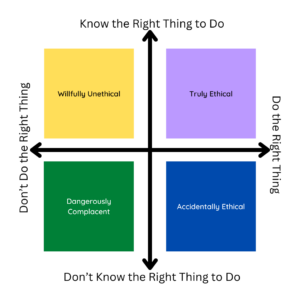Chapter 3: Respectful
 Showing respect or being respectful is a common quality of a workplace, home environment, or really anywhere we, humans, exist. It is important to be respectful to the environment, the people you work with, as well as any other entities such as plants, animals, and so on. In the following chapter, respect will be extrapolated to a larger construct: an ethical matrix. An ethical matrix provides a guide for ethical decision-making which is also respectful to the stakeholders.
Showing respect or being respectful is a common quality of a workplace, home environment, or really anywhere we, humans, exist. It is important to be respectful to the environment, the people you work with, as well as any other entities such as plants, animals, and so on. In the following chapter, respect will be extrapolated to a larger construct: an ethical matrix. An ethical matrix provides a guide for ethical decision-making which is also respectful to the stakeholders.
Why does it matter? Zhao et al. (2022) shares in their research that perceived respect fuels innovation while also increasing the thriving dynamic within an organization. Basically: respect really matters – to everyone.
Ethical Matrix for Respectful Decision Making

Originally developed in 2006 by Ben Mepham et al., the ethical matrix provides visual guide for decision makers, whether in groups or as individuals. It asks the user(s) to decide the ethical acceptability for each potential decision or technology. Originally developed with food and agriculture in mind, it also a great resource to consider for leadership decisions. The original manual states it could be used in government committees, ethics groups at any level, non-governmental organizations, public entities, and commercial enterprises (Mepham et al., 2006). Which makes it perfect for the readers of this book! It works for everyone!
There are three main components of the ethical matrix: well-being, autonomy, and fairness. Let’s discuss each a little bit more.
- Well-being refers to the “physical and psychological welfare” associated with an individual, including pain, anxiety, happiness, sadness, and so on (Biasetti & de Mori, 2021).
- Autonomy refers to self-determination, embraced uniqueness, and freedoms.
- Fairness is “complementary” to autonomy, where autonomy focuses on all of the things which make us different, fairness focuses on an equal field for all, removing differences deemed as “irrelevant” to the decision such as race or sex (Biasetti & de Mori, 2021).
Steps to Creating an Ethical Matrix
Step 1
In order to set up an ethical matrix, start by creating a chart like the one below which uses these three components as the evaluating criteria. It might be helpful to have an associated guide which would define each of these terms within the context of your organization or group. Additionally, you could have additional evaluating criteria based on the information gathered about the situation; this is just a guideline (Biasetti & de Mori, 2021).

Step 2
Next, determine who the relevant stakeholders are to your decision. It might be beneficial to start from the most direct impact to the more indirect. You can make your stakeholders as specific or as general as you need to; just make sure all relevant persons are recognized. It may be helpful to brainstorm, take a break, and come back to the chart; just to make sure everyone is represented.

Step 3
After all of the relevant stakeholders are identified on the matrix, begin conducting a reflective exercise where information about a technology, program, directive (etc.) is assessed from each stakeholder perspective in relation to the evaluating criteria. This could take time – so don’t rush it!
Caution! It is important to note, however, while the matrix can improve ethical decision-making, it does require each participant in the evaluation to reflect, agree, and communicate regarding the course of action. The matrix is not going to magically produce a decision, more thought is involved than just filling in boxes (Mepham, et al., 2006).
Ethics Matrix – Another Perspective
Another view of an ethics matrix is more like plotting points on a graph. Binnie (2020) shares different versions of (un)ethical behaviors. Truly ethical means the organization knows what is “right” and always does “it”. Accidentally ethical means the business has ambiguous codes but still seems to manage ethical practices. In this situation, they need to update their code of ethics. There’s two more categories: dangerously complacent and willfully unethical. These situations don’t know or maybe don’t want to know what the right thing is and may lean toward unethical behavior.
Consider some of the big decisions you’ve made in the last year, where each of those decisions fall, based on the graphic below?

Check Yourself
Review the ethical questions below (Seglin, 2010) and ask yourself where you would fall on the matrix provided above :
- If something at a sale is far more valuable than posted, do I have to let the seller know?
- Is it considered stealing to take pens from a bank? What about napkins or jelly from a restaurant?
- Is it unethical to use address labels a charity sends you, without a prior donation?
- If it unfair to move into different seats at an event, which are better and open?
- If an offensive joke is told, should I speak up about it?
- My supervisor asked for me to cover for them on the expense report, should I do it?
References
Biasetti, P., & de Mori, B. (2021). The Ethical Matrix as a tool for decision-making process in conservation. Frontiers in Environmental Science. 9:584636. doi: 10.3389/fenvs.2021.584636
Binnie, A. (2020). Where is your company on the Ethics Matrix? Tovera Consulting. Retrieved on October 9, 2023 from https://www.tovera.consulting/where-is-your-company-on-the-ethics-matrix/
Kundu, S. (2019). The importance of ethical decision making in the age of technology [Video]. YouTube. https://www.youtube.com/watch?v=q-nhktqMoT4
Mepham, B., Kaiser, M., Thoerstensen, E., Tomkins, S., & Millar, K. (2006). Ethical Matrix manual. Retrieved on October 9, 2023 from https://www.researchgate.net/publication/254833030_Ethical_Matrix_Manual
Seglin, J. (2010). 10 ethical questions, answered. CNN. Retrieved on October 9, 2023 from http://www.cnn.com/2010/LIVING/wayoflife/03/10/rs.10.ethical.questions/index.html
Zhao, L., Liu, P., Zhang, F., Xu, S., Lie, Y. (2022). How does perceived respect affect innovative behavior? The role of thriving at work and spiritual leadership. Frontiers in Psychology, 13. https://doi.org/10.3389/fpsyg.2022.978042

